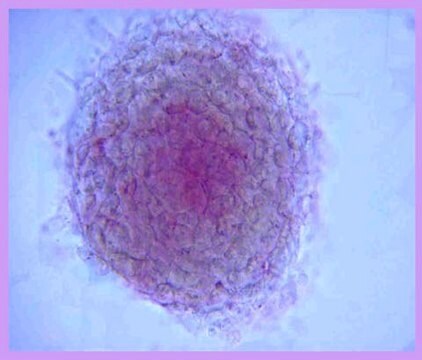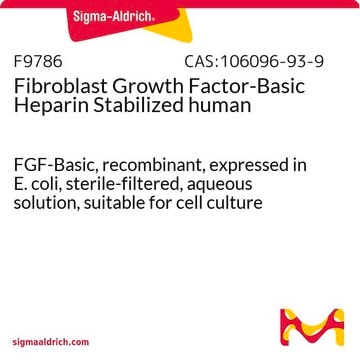SCR030
Human Embryonic Germ Layer Characterization Kit
CHEMICON′s Human Embryonic Germ Layer Characterization Kit allows researchers to assess the differentiation potential of their Human Embryonic Stem Cell (HESC) to form derivatives of all three embryonic germ layers.
Sign Into View Organizational & Contract Pricing
All Photos(1)
About This Item
UNSPSC Code:
12352207
eCl@ss:
32161000
NACRES:
NA.84
Recommended Products
Quality Level
species reactivity
human
manufacturer/tradename
Chemicon®
technique(s)
cell culture | stem cell: suitable
immunocytochemistry: suitable
input
sample type induced pluripotent stem cell(s)
sample type: human embryonic stem cell(s)
shipped in
wet ice
General description
Human embryonic stem cells (HESC) are pluripotent stem cells that are capable of self-renewal and of differentiation in vitro and in vivo into a wide variety of cell types, including derivatives of all three embryonic germ layers. These primary germ layers will eventually give rise to all the tissues and organs of the body.
Mesoderm: bone, cartilage, muscle, blood and vascular system
Endoderm: gastrointestinal tract, respiratory tract and endocrine glands (including liver and pancreas)
Ectoderm: nervous system, skin
CHEMICON®′s Human Embryonic Germ Layer Characterization Kit (SCR030) allows researchers to assess the differentiation potential of their HESC to form derivatives of all three embryonic germ layers. Included in the kit are antibodies that are routinely used by stem cell researchers to identify the lineage fates of HESC following either spontaneous or directed differentiation.
Mesoderm: Smooth Muscle Actin (CBL171)
Cardiac Troponin I (MAB1691-50UG)
Endoderm: Alpha Fetoprotein (2004189)
Ectoderm: Nestin (ABD69)
MAP-2 (MAB3418-50UG)
Mesoderm: bone, cartilage, muscle, blood and vascular system
Endoderm: gastrointestinal tract, respiratory tract and endocrine glands (including liver and pancreas)
Ectoderm: nervous system, skin
CHEMICON®′s Human Embryonic Germ Layer Characterization Kit (SCR030) allows researchers to assess the differentiation potential of their HESC to form derivatives of all three embryonic germ layers. Included in the kit are antibodies that are routinely used by stem cell researchers to identify the lineage fates of HESC following either spontaneous or directed differentiation.
Mesoderm: Smooth Muscle Actin (CBL171)
Cardiac Troponin I (MAB1691-50UG)
Endoderm: Alpha Fetoprotein (2004189)
Ectoderm: Nestin (ABD69)
MAP-2 (MAB3418-50UG)
Application
CHEMICON′s Human Embryonic Germ Layer Characterization Kit allows researchers to assess the differentiation potential of their Human Embryonic Stem Cell (HESC) to form derivatives of all three embryonic germ layers.
Research Category
Stem Cell Research
Stem Cell Research
Components
50 μL of Alpha Fetoprotein mouse monoclonal 2004189
50 μg of Smooth Muscle Actin mouse monoclonal CBL171
50 μL of Nestin rabbit polyclonal ABD69
50 μg of Cardiac Troponin I mouse monoclonal MAB1691-50UG
50 μg of MAP-2 mouse monoclonal MAB3418-50UG
50 μg of Smooth Muscle Actin mouse monoclonal CBL171
50 μL of Nestin rabbit polyclonal ABD69
50 μg of Cardiac Troponin I mouse monoclonal MAB1691-50UG
50 μg of MAP-2 mouse monoclonal MAB3418-50UG
Storage and Stability
Maintain components according to the individual data sheets. Antibodies to alpha fetoprotein (2004189) and nestin (ABD69) are to be stored at -20°C (SCR030 - Part 1). Antibodies to smooth muscle actin (CBL171), cardiac troponin I (MAB1691-50UG) and MAP-2 (MAB3418-50UG) are to be stored at 2 - 8°C (SCR030 - Part 2).
Legal Information
CHEMICON is a registered trademark of Merck KGaA, Darmstadt, Germany
Disclaimer
Unless otherwise stated in our catalog or other company documentation accompanying the product(s), our products are intended for research use only and are not to be used for any other purpose, which includes but is not limited to, unauthorized commercial uses, in vitro diagnostic uses, ex vivo or in vivo therapeutic uses or any type of consumption or application to humans or animals.
signalword
Warning
hcodes
Hazard Classifications
Acute Tox. 4 Dermal - Acute Tox. 4 Inhalation - Aquatic Chronic 3
Storage Class
10 - Combustible liquids
Certificates of Analysis (COA)
Search for Certificates of Analysis (COA) by entering the products Lot/Batch Number. Lot and Batch Numbers can be found on a product’s label following the words ‘Lot’ or ‘Batch’.
Already Own This Product?
Find documentation for the products that you have recently purchased in the Document Library.
Julie Brault et al.
BioResearch open access, 3(6), 311-326 (2014-12-04)
Chronic granulomatous disease (CGD) is an inherited orphan disorder caused by mutations in one of the five genes encoding reduced nicotinamide-adenine-dinucleotide-phosphate oxidase subunits, which subsequently lead to impairment in the production of microbicidal reactive oxygen species (ROS). In order to
Murali Krishna Mamidi et al.
Journal of biomolecular screening, 15(6), 630-643 (2010-06-10)
Techniques to evaluate gene expression profiling, including real-time quantitative PCR, TaqMan low-density arrays, and sufficiently sensitive cDNA microarrays, are efficient methods for monitoring human embryonic stem cell (hESC) cultures. However, most of these high-throughput tests have a limited use due
Our team of scientists has experience in all areas of research including Life Science, Material Science, Chemical Synthesis, Chromatography, Analytical and many others.
Contact Technical Service








